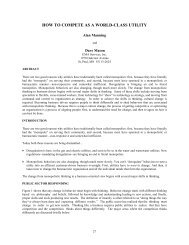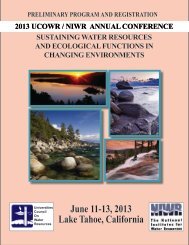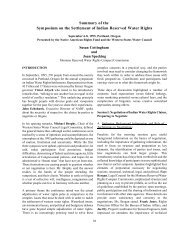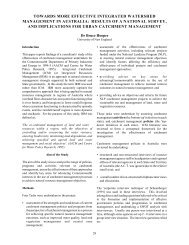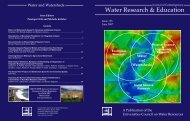Full Journal of Contemporary Water Research and Education, Issue ...
Full Journal of Contemporary Water Research and Education, Issue ...
Full Journal of Contemporary Water Research and Education, Issue ...
Create successful ePaper yourself
Turn your PDF publications into a flip-book with our unique Google optimized e-Paper software.
110Bourgetwith over 600 people responding. In addition to theshort number questions, many <strong>of</strong> the respondentstook the time to answer the separate discussionquestions that were included in the survey, thusyielding substantial results. At the outset <strong>of</strong> thesurvey, the respondents were asked whether ornot they would be representing their own personalviews or those <strong>of</strong> their respective organizationsthrough the course <strong>of</strong> the survey; 91 percent <strong>of</strong>those responding stated that they were voicingtheir own personal views.Importance <strong>of</strong> IWRMThe respondents were asked, on a scale <strong>of</strong> 1(low) to 5 (high) how important the integration<strong>of</strong> multi-disciplinary education <strong>and</strong> application inwater resources management was to accomplishingtheir organization’s mission. Nearly everyoneresponded to this question, with 85 percent <strong>of</strong>them feeling that it was very important. Less than5 percent viewed it as unimportant to their mission,while 10 percent gave it the mid-rating <strong>of</strong> 3.IWRM ResponsibilitiesFor the next question, those surveyed wereasked to define their area <strong>of</strong> responsibility on thesame scale <strong>of</strong> 1 to 5 from an assigned list <strong>of</strong> 20specialty areas. The purpose <strong>of</strong> this question wasto determine what capacity <strong>of</strong> IWRM they felt theybest represent. The ranges for this question werenot substantial, with the rather nebulous entry <strong>of</strong>water resources management receiving the highestresponse average <strong>of</strong> 4.31. In a field <strong>of</strong> 20 subspecialtyareas associated with IWRM no oneparticular area <strong>of</strong> responsibility stood out from thisparticular field <strong>of</strong> respondents 3 . At the same time,no field was discounted, suggesting how rich <strong>and</strong>varied the field is in practice.Training Disciplines <strong>of</strong> ImportanceIt was very important to glean from therespondents which educational areas should beprimarily targeted for the purposes <strong>of</strong> deriving anIWRM curriculum. For this question, 14 separatedisciplines 4 were provided for the respondents tochoose from. They were asked to identify which <strong>of</strong>these areas <strong>of</strong> training would help their organizationaccomplish their mission. The leading response waswatershed hydrology <strong>and</strong> modeling with 86 percent<strong>of</strong> the survey respondents. The specialty area <strong>of</strong>geographic information systems (geography) camein second at 75 percent (Figure 1).1009080706050403020100<strong>Water</strong>shed Hydrol/ModelingGIS/Geography<strong>Water</strong> ChemistryCivil EngineeringBiology/Life SciencesLaw/RegulatoryGeologyPublic PolicyStatisticsSoils/AgronomyEconomicsMeteorologyMicrobiologyForest/Rangel<strong>and</strong> MgmtFigure 1. Breakdown <strong>of</strong> disciplinary education/training areas <strong>of</strong> interest.UCOWRJOURNAL OF CONTEMPORARY WATER RESEARCH & EDUCATION



